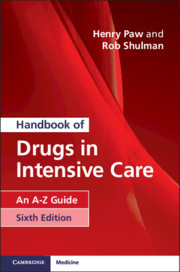Description
Handbook of Drugs in Intensive Care (6th Ed., Revised edition)
An A-Z Guide
Authors: Paw Henry, Shulman Rob
This essential new edition provides current information on how to use drugs safely and effectively in the intensive care setting.
Language: English
Subject for Handbook of Drugs in Intensive Care:
Approximative price 36.76 €
In Print (Delivery period: 14 days).
Add to cart
Publication date: 07-2019
444 p. · 12.2x18.5 cm · Paperback
444 p. · 12.2x18.5 cm · Paperback
Description
/li>Contents
/li>Biography
/li>
Now in its sixth edition, the Handbook of Drugs in Intensive Care is the essential guide to using drugs safely and effectively in the intensive care setting. The book is split into two sections: an A-Z guide to the drugs available, and concise notes on the key topics and situations faced on a daily basis. The A-Z section provides succinct information on each drug including uses, limitations, administration directions and adverse effects. The second section details practice guidelines such as insulin therapy, Parkinson's disease therapy when nil-by-mouth, and drug dosing in renal failure. This revised edition includes seventeen new drug monographs and covers several new topics, including blood glucose management. A colour chart showing drug compatibility for intravenous administration is included at the back of the book. Presented in a concise, compact format, this book is an invaluable resource for doctors, nurses, pharmacists and other healthcare professionals caring for critically ill patients.
Introduction; How to use this book; Abbreviations; Acknowledgements; Drugs: An A-Z Guide; Prescribing using generic or brand names; Routes of administration; Loading dose; Drug metabolism; Enzyme systems; Drug excretion; Drug tolerance; Drug interactions; Therapeutic drug monitoring; Target range of concentration; Pharmacology in the critically ill; Body weight; Guide to ideal tidal volume; Cardiopulmonary resuscitation; Drugs in advanced life support; Management of acute major anaphylaxis; Management of acute severe hyperkalaemia; Management of malignant hyperthermia; Sedation, analgesia and neuromuscular blockade; Opioid conversion table; Antiretroviral drugs: alternatives for swallowing difficulties; Management of status epilepticus; Prevention of delirium tremens and alcohol withdrawal syndrome; Prevention of Wernicke–Korsakoff syndrome; Anti-arrhythmic drugs; Inotropes and vasopressors; Bronchospasm; Anti-ulcer drugs; Immunonutrition in the ICU; Corticosteroids; Short synacthen test; Bone marrow rescue following nitrous oxide; Heparin induced thrombocytopaenia; NOAC/DOAC; Antioxidants; Guidelines for patients with absent or dysfunctional spleen; Anti-microbial drugs; Bacterial gram staining; Antibiotics: sensitivities; Alterations to drug dosing in renal dysfunction and Haemo(dia)filtration; Chemical pleurodesis of malignant pleural effusion; Appendix A: creatinine clearance; Appendix B: weight conversion (stones/lb to kg); Appendix C: body mass index (BMI) calculator; Appendix D: lean body weight charts; Appendix E: ideal tidal volume; Appendix F: estimated height from ulna length; Appendix G: infusion rate/dose calculation; Appendix H: drug compatibility chart; Appendix I: sodium content of oral medications; Appendix J: drug management of the brain-stem-dead donor; Appendix K: vancomycin by continuous infusion; Appendix L: Child-Pugh score; Appendix M: severe sepsis algorithm; Appendix N: insulin guidelines; Drug index.
Henry Paw is a consultant in intensive care medicine at York Hospital.
Rob Shulman is the lead pharmacist in critical care at University College London Hospitals, London.
Rob Shulman is the lead pharmacist in critical care at University College London Hospitals, London.
© 2024 LAVOISIER S.A.S.



